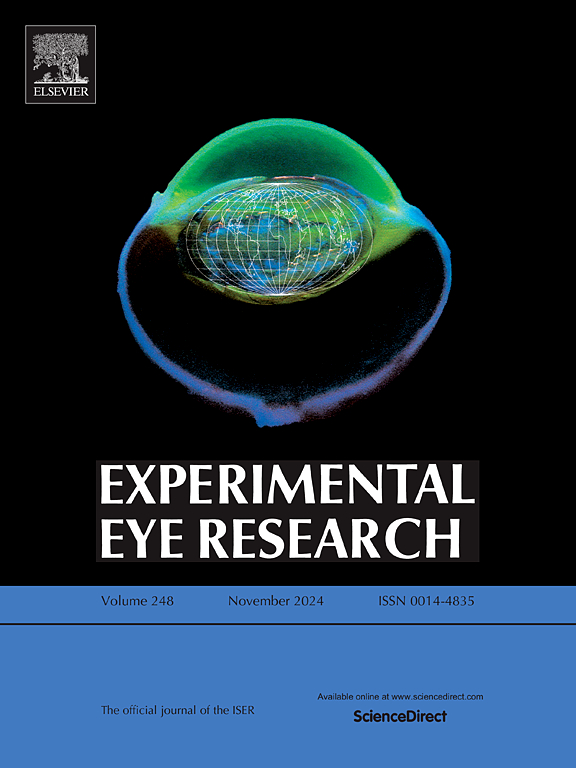Binocular dysfunction in Parkinson's Disease: Decoding near triad dynamics and divergence deficits
IF 3
2区 医学
Q1 OPHTHALMOLOGY
引用次数: 0
Abstract
Parkinson's Disease (PD) is a progressive neurodegenerative disorder that often affects the oculomotor system, causing strabismus and vergence impairments, particularly convergence insufficiency when focusing on nearby objects. This study evaluated eye deviation, vergence, accommodation, and pupil responses in PD during converging and diverging gaze shifts, correlating these findings with neurologic severity using the Unified Parkinson's Disease Rating Scale (UPDRS). We recruited 19 participants with varying severity of PD and 10 age-matched controls. 26 % of PD participants (PD Group 1) exhibited disparity-driven convergence and divergence responses comparable to controls, with expected miosis during convergence and mydriasis during divergence. In contrast, 74 % of PD participants (PD Group 2) showed reduced disparity-driven convergence and divergence, with diminished miosis during convergence and mydriasis during divergence. 37 % of PD participants exhibited increased exodeviation at near (30 cm) during binocular viewing in addition to reduced disparity-driven convergence. Blur-driven vergence was more significantly reduced than disparity-driven vergence in both PD participants and controls, likely due to presbyopia. Accommodation, assessed through changes in refractive error during disparity-driven and blur-driven vergence movements, was comparable between controls and PD patients. Our study indicates that PD disrupts disparity-driven convergence and divergence while sparing accommodation and blur-driven vergence. These findings offer insight into the pathophysiology of binocular dysfunction in PD, highlighting the involvement of neural structures such as the deep cerebellar nuclei and the supra-oculomotor area in vergence deficits and strabismus. Future studies can use these metrics to evaluate the effectiveness of targeted neuromodulation therapies in alleviating binocular dysfunction in PD.
帕金森病的双眼功能障碍:解码近三联征动力学和发散缺陷
帕金森病(PD)是一种进行性神经退行性疾病,常影响眼球运动系统,引起斜视和会聚功能障碍,特别是聚焦附近物体时会聚功能不全。本研究评估了PD患者在注视转移和注视转移过程中的眼偏、视散、调节和瞳孔反应,并使用统一帕金森病评定量表(UPDRS)将这些结果与神经系统严重程度联系起来。我们招募了19名患有不同严重程度PD的参与者和10名年龄匹配的对照组。26%的PD参与者(PD组1)表现出与对照组相当的差异驱动的收敛和发散反应,预期在收敛期间有缩小,在发散期间有散丝。相比之下,74%的PD参与者(PD组2)表现出差异驱动的趋同和分化减少,趋同期间的缩小和分化期间的散丝减少。在双眼观察时,37%的PD参与者在近(30厘米)处表现出增加的外偏移,此外还有减少的视差驱动的收敛。在PD参与者和对照组中,模糊驱动的聚光比差异驱动的聚光明显减少,可能是由于老花眼。通过视差驱动和模糊驱动的聚光运动期间屈光不正的变化来评估调节,在对照组和PD患者之间具有可比性。我们的研究表明,PD破坏了差异驱动的收敛和发散,而保留了适应和模糊驱动的收敛。这些发现为帕金森病双眼功能障碍的病理生理学提供了深入的见解,强调了神经结构,如小脑深部核和动眼肌上区在会聚缺陷和斜视中的参与。未来的研究可以使用这些指标来评估靶向神经调节疗法在缓解PD患者双眼功能障碍方面的有效性。
本文章由计算机程序翻译,如有差异,请以英文原文为准。
求助全文
约1分钟内获得全文
求助全文
来源期刊

Experimental eye research
医学-眼科学
CiteScore
6.80
自引率
5.90%
发文量
323
审稿时长
66 days
期刊介绍:
The primary goal of Experimental Eye Research is to publish original research papers on all aspects of experimental biology of the eye and ocular tissues that seek to define the mechanisms of normal function and/or disease. Studies of ocular tissues that encompass the disciplines of cell biology, developmental biology, genetics, molecular biology, physiology, biochemistry, biophysics, immunology or microbiology are most welcomed. Manuscripts that are purely clinical or in a surgical area of ophthalmology are not appropriate for submission to Experimental Eye Research and if received will be returned without review.
 求助内容:
求助内容: 应助结果提醒方式:
应助结果提醒方式:


